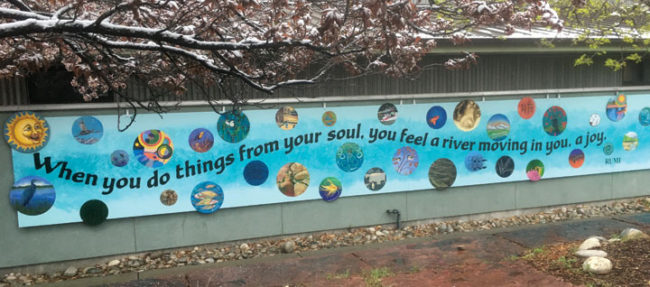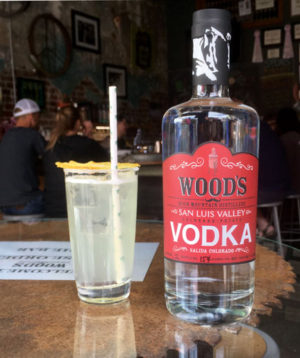By Jane Ewing
Public art slows down pedestrians so they can enjoy their space and helps promote a positive impact on one’s mood. It engages people in art in the course of daily lives. Civic art adds distinctiveness to our communities and humanizes our outdoor places.
Local aesthetics is one reason people attach themselves to a community. Salida has the character and ample sense of beauty to validate its allure. Good things happen in this town in the heart of the Rockies, such as the collaboration of Salida residents who recently designed and installed a mural in the SteamPlant’s Strawn/Grether Sculpture Garden near the banks of the Arkansas River, adjacent to the SteamPlant Event Center, and a few steps from the town’s notable historic district.
The intent in creating the mural was to replace one that had long been valued in the sculpture garden. It seemed time to create something different. The committee was comprised of local creative people who designed, fabricated and installed the mural. They were driven not only by a wish to contribute to the community’s aesthetics, but by the chance to express their sense of belonging. It was an opportunity to collaborate with others in making an art piece that would be part of the sculpture park – a distinctive public setting. The use of nontraditional surfaces and materials stimulated vibrant expressions and imagination. Equally important, producing the mural was a means for them to share creativity, personally and publicly, in a big way. All who participated in the project found it was their great fortune to do so.
[InContentAdTwo]
The mural’s theme reflects the character of a river. Artistic renderings are meant to reveal the spirit of the Arkansas River that flows nearby. The sentiment in the quotation that is lettered across the mural conveys the mood of a river: “When you do things from your soul you feel a river moving in you, a joy.” – Rumi. Those words are the focal point of the mural’s design.

The structure of the mural consists of four eight- by four-foot wooden panels that are connected by interlocking metal braces. The panels are hung on the side of the building that borders one end of the garden and, consequently, serve as a backdrop for the sculptures and the plants. Gradations of pale blue paint were sponged on the panels to give a stylized rendering of the Arkansas River. Letters in the quotation are positioned over the river image and extend horizontally nearly end-to-end of the 32-foot-long piece.
Most members of the committee expressed their personal interpretation of a river on one or more of the 37 aluminum rounds that were cut in various dimensions, from 8 to 18 inches in diameter. Each is distinctive. The renderings represent a variety of artistic styles, from abstract to gestural to graphic to realistic. Techniques also vary, as do the colors and media. The disks that are fastened on the panels integrate with the stretch of words and river image. Those circles symbolize bubbles in the rapids of the Arkansas River.
The finished composition is fitting and captivating. It reflects the vibrant character of Salida. The image was not only a nod to the Arkansas River but to the spirit of the people of Salida. The mural is valuable because, as with all public art, it helps to give the community a strong sense of place.
Artists who contributed to the mural were: Roberta Smith, Padgett McFeely, Sally Mather, Fay Golson, Donna Wagel, Mathew Varnum, Merry Cox, David LaVercombe, Rich Tyler, Sandy Starnaman, Mel Strawn, Shelby Cox, Kay Litz, Jane Ewing, Wally Ewing, Jude Silva, Paulette Broduer, Ken Brandon, Dee Sapper and Julie Maas.
Jane Ewing’s inspiration comes from some corner of her spleen.


